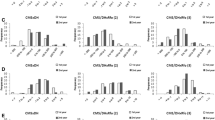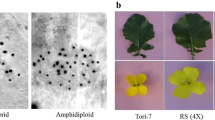Abstract
The heritability, the number of segregating genes and the type of gene interaction of nine agronomic traits were analysed based on F2 populations of synthetic oilseedBrassica napus produced from interspecific hybridization ofB. campestris andB. oleracea through ovary culture. The nine traits—plant height, stem width, number of branches, length of main raceme, number of pods per plant, number of seeds per pod, length of pod, seed weight per plant and 1000-seed weight—had heritabilities of 0.927, 0.215, 0.172, 0.381, 0.360, 0.972, 0.952, 0.516 and 0.987 respectively, while the mean numbers of controlling genes for these characters were 7.4, 10.4, 9.9, 12.9, 11.5, 21.7, 20.5, 19.8 and 6.4 respectively. According to estimated coefficients of skewness and kurtosis of the traits tested, no significant gene interaction was found for plant height, stem width, number of branches, length of main raceme, number of seeds per pod and 1000-seed weight. Seed yield per plant is an important target for oilseed production. In partial correlation analysis, number of pods per plant, number of seeds per pod and 1000-seed weight were positively correlated with seed yield per plant. On the other hand, length of pod was negatively correlated (r = -0.69) with seed yield per plant. Other agronomic characters had no significant correlation to seed yield per plant. In this experiment, the linear regressions of seed yield per plant and other agronomic traits were also analysed. The linear regression equation wasy = 0.074x8 + 1.819x9 + 6.72x12 -60.78 (R 2 = 0.993), wherex 8, x9 and x12 represent number of pods per plant, number of seeds per pod and 1000-seed weight respectively. The experiment also showed that erucic acid and oil contents of seeds from F2 plants were lower than those of their maternal parents. However, glucosinolate content was higher than that of the maternal plants. As for protein content, similar results were found in the F2 plants and their maternal parents. It was shown that the four quality traits, i.e. erucic acid, glucosinolate, oil content, and protein content, had heritability values of 0.614, 0.405, 0.153 and 0.680 respectively.
Similar content being viewed by others
References
Agnihotri A., Lakshmikumaran M. S., Prakash S. and Jagannathan V. 1991 Embryo rescue ofB. napus ×Raphanobrassica hybrids.Cruciferae Newsl. 14, 92–93.
Ayotte R., Harney P. M., Seuza M. V. 1987 Transfer of triazine resistance fromBrassica napus toB. oleracea L. I. Production of Fi hybrids through embryo rescue.Euphytica 36, 615–624.
Caranta C. and Palloix A. 1996 Both common and specific genetic factors are involved in polygenic resistance of pepper to several potyviruses.Theor. Appl. Genet. 92, 15–20.
Chen S. Z., Yin J. M., Tang Z. L. and Li J. N. 2000 A preliminary study on interspecific hybridization betweenBrassica napus andB. oleracea vanaceaphala.J. Southwest Agric. Univ. 22, 208–210.
Chen Y. and Wojciechowski A. 2000 Obtained interspecific hybrid ofB. napus andB. oleracea vanitalica by embryo and ovulein vitro culture.J. Huazhong Agric. Univ. 19, 274–278.
Choo T. M. and Reinbergs E. 1982a Estimation of the number of genes in doubled haploid population of barley (Hordeum vulg→e).Can. J. Genet. Cytol. 24, 337–341.
Choo T. M. and Reinbergs E. 1982b Analyses of skewness and kurtosis for detecting gene interaction in a doubled haploid.Crop Sci. 22, 231–235.
Gu H. H., Zhou W. J. and Hagberg P. 2003 High frequency spontaneous production of doubled haploid plants from microspore culture inBrassica rapa ssp.chinensis. Euphytica 134, 239–245.
Gu H. H., Hagberg P. and Zhou W. J. 2004 Cold pretreatment enhances microspore embryogenesis in oilseed rape (Brassica napus L.).Plant Growth Regul. 42, 137–143.
Han J. Q. and Liu H. L. 1993 Principal component analysis for main agronomic and quality characters of hybrids in rapeseed (Brassica napus L.).J. Huazhong Agric. Univ. 12, 427–432.
Heath D. W. and Earle E. D. 1996 Resynthesis of rapeseed (Brassica napus L.): A comparison of sexual versus somatic hybridization.Plant Breed.115, 395–401.
Jourdan P. S., Earle E. D. and Mutschier M. A. 1989 Synthesis of male sterile, triazine-resistantBrassica napus by somatic hybridization between cytoplasmic male sterileB. oleracea and atrazine-resistantB. campestris.Theor. Appl. Genet. 78, 445–455.
Leonardo V. and Becker H. C. 1998 Analysis of total glucosinolate content and individual glucosinolate inBrassica spp. by near infrared reflectance spectroscopy.Plant Breed. 117, 97–102.
Leul M. and Zhou W. J. 1998 Alleviation of waterlogging damage in winter rape by uniconazole application: Effects on morphological characteristics, hormones and photosynthesis.Field Crops Res. 59, 121–127.
Leul M. and Zhou W. J. 1999 Alleviation of waterlogging damage in winter rape by uniconazole application: Effects on enzyme activity, lipid peroxidation and membrane integrity.J. Plant Growth Regul. 18, 9–14.
Li A. M., Zhang Y. T. and Hui F. H. 2001 Analysis of the characters of hybrid rapeseed combination and major breeding goals.J. Anhui Agric. Sci. 29, 308–310.
Liu H. L. 1984Genetics and breeding of oilseed rape. Shanghai Science and Technology Press, Shanghai.
McNaughten I. M. 1963 The scope and problems involved in synthesizing new amphidiploid and autotetraploid fodder brassicas in the group ofB. napus L.,B. campestris L. andB. oleracea L.Scott. Plant Breed. Station Rec. 48–68.
Momoh E. J., Song W. J., Li H. Z. and Zhou W. J. 2004 Seed yield and quality responses of winter oilseed rape (Brassica napus) to plant density and nitrogen fertilization.Indian J. Agric. Sci. 74, 420–424.
Momoh E. J. J. and Zhou W. J. 2001 Growth and yield responses to plant density and stage of transplanting in winter oilseed rape (Brassica napus L.).J. Agron. Crop Sci. 186, 253–259.
Momoh E. J. J., Zhou W. J. and Kristiansson B. 2002 Variation in the development of secondary dormancy in oilseed rape genotypes under conditions of stress.Weed Res. 42, 446–455.
Nishi S. 1980 Differentiation of Brassica crops in Asia and the breeding of ‘hakuran’, a newly synthesized leafy vegetable. InBrassica crops and wild allies—biology and breeding (ed. S. Tsunoda, K. Hinata and C. Gomez-Campo), pp. 133–150. Japan Scientific Societies Press, Tokyo.
Quazi M. H. 1988 Interspecific hybrids betweenBrassica napus L. andB. oleracea L. developed by embryo culture.Theor. Appl. Genet. 75, 309–318.
SPSS 1999SPSS for Windows, version 10.0. SPSS Inc., Chicago, USA.
Tang G. X., Zhou W. J., Li H. Z., Mao B. Z., He Z. H. and Yoneyama K. 2003 Medium, expiant and genotype factors influencing shoot regeneration in oilseedBrassica spp.J. Agron. Crop Sci. 189, 351–358.
Wu J. G., Shi C. H. and Fan L. J. 2002 Calibration optimization for analyzing erucic acid and glucosinolate content of rapeseed by near infrared reflectance spectroscopy.J. China Cereal Oil Assoc. 17, 59–62.
Xu L. Y., Yang J. X. and Xuan P. 1995 A study on distant hybridization betweenBrassica napus andRaphanus sativus var.oleifera.J. Southwest Agric. Univ. 17, 102–106.
Yu F. Q., Jin M. G., Xiao C. S. and Wang L. 1998 Genetic analyses of several quantitative traits of doubled haploid population inBrassica napus L.Sci. Agric. Sin. 31, 44–48.
Zhang G. Q., Zhou W. J., Yao X. L. and Zhang Z. J. 2001 Studies on distant hybridization inBrassica plants.J. Shanxi Agric. Sci. 29, 25–30.
Zhang G. Q., Tang G. X. and Zhou W. J. 2003a A preliminary study on the interspecific hybridization ofB. campestris andB. oleracea through ovary culture.Sci. Agric. Sin. 36, 1409–1413.
Zhang G. Q., Zhou W. J., Gu H. H., Song W. J. and Momoh E. J. J. 2003b Plant regeneration from the hybridization ofBrassica juncea andB. napus through embryo culture.J. Agron. Crop Sci. 189, 347–350.
Zhang G. Q., Tang G. X., Song W. J. and Zhou W. J. 2004 ResynthesizingBrassica napus from interspecific hybridization betweenBrassica rapa andB. oleracea through ovary culture.Euphytica 140, 181–187.
Zhang N. Y. and Xue Q. Z. 1997 Genetic analysis of some quantitative traits with doubled haploid population in rice (Oryza saliva L.).Acta Agron. Sin. 23, 123–126.
Zhou W. J. 2001 Oilseed rape. InCrop production (ed. G. P. Zhang and W. J. Zhou), pp. 153–178. Zhejiang University Press, Hangzhou.
Zhou W. J., Zhao D. S. and Lin X. Q. 1997 Effects of waterlogging on nitrogen accumulation and alleviation of waterlogging damage by application of nitrogen fertilizer and mixtalol in winter rape (Brassica napus L.).J. Plant Growth Regul. 16, 47–53.
Zhou W. J., Hagberg P. and Tang G. X. 2002a Increasing embryogenesis and doubling efficiency by immediate colchicine treatment of isolated microspores in springBrassica napus.Euphytica 128, 27–34.
Zhou W. J., Tang G. X. and Hagberg P. 2002b Efficient production of doubled haploid plants by immediate colchicine treatment of isolated microspores in winterBrassica napus.Plant Growth Regul. 37, 185–192.
Zhou W. J., Zhang G. Q., Tuvesson S., Dayteg C. and Gertsson B. 2006 Genetic survey of Chinese and Swedish oilseed rape (Brassica napus L.) by simple sequence repeats (SSRs).Genet. Resour. Crop Evol.,53, 443–447.
Zhu J. 1992 Mixed model approaches for estimating genetic variances and covariances.J. Biomath. 7, 1–11.
Zhu J. and Weir B. S. 1994 Analysis of cytoplasmic and maternal effects. I. A genetic model for diploid plant seeds and animals.Theor. Appl. Genet. 89, 153–159.
Author information
Authors and Affiliations
Corresponding author
Rights and permissions
About this article
Cite this article
Zhang, G., Zhou, W. Genetic analyses of agronomic and seed quality traits of synthetic oilseedBrassica napus produced from interspecific hybridization ofB. campestris andB. oleracea . J Genet 85, 45–51 (2006). https://doi.org/10.1007/BF02728969
Received:
Issue Date:
DOI: https://doi.org/10.1007/BF02728969




